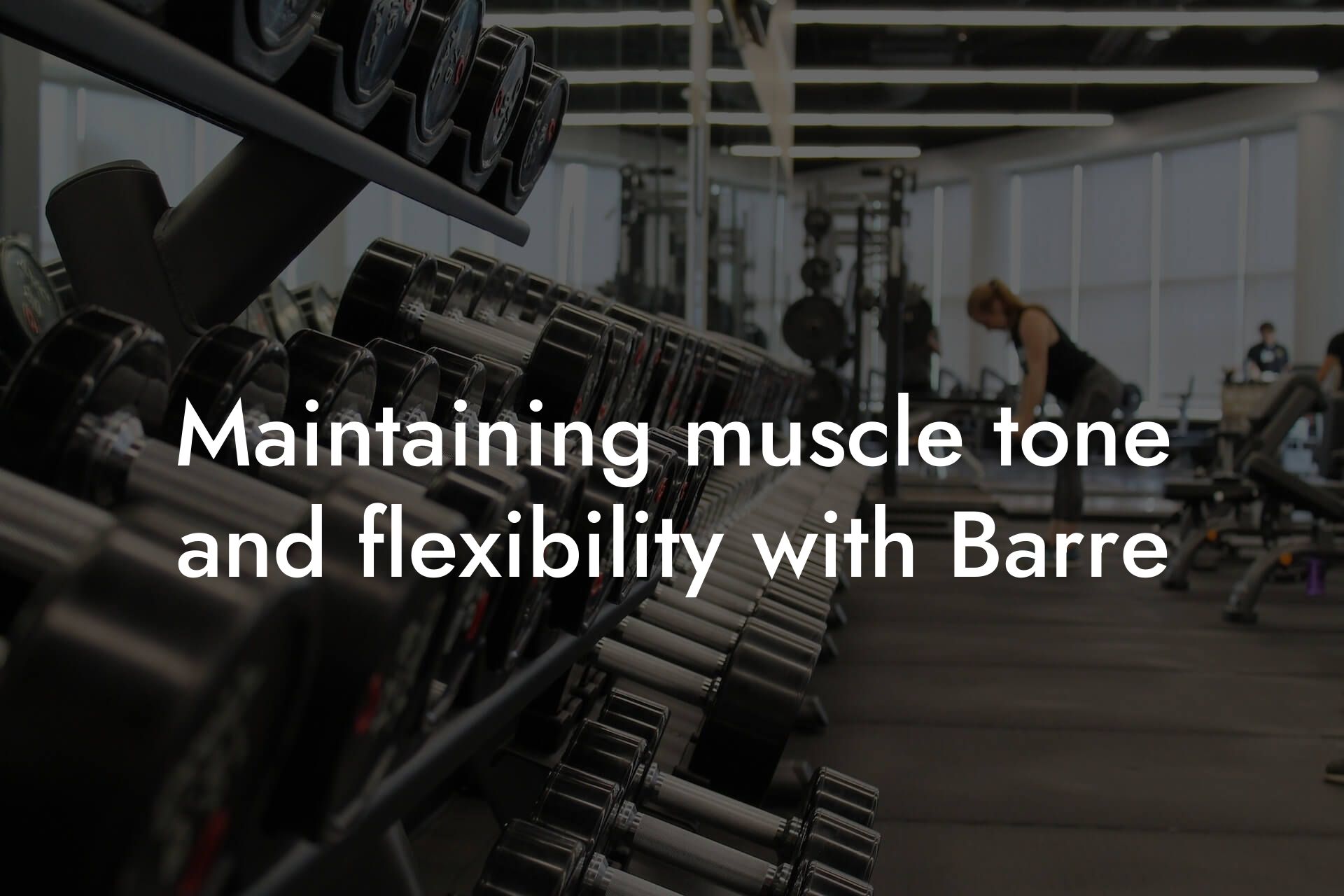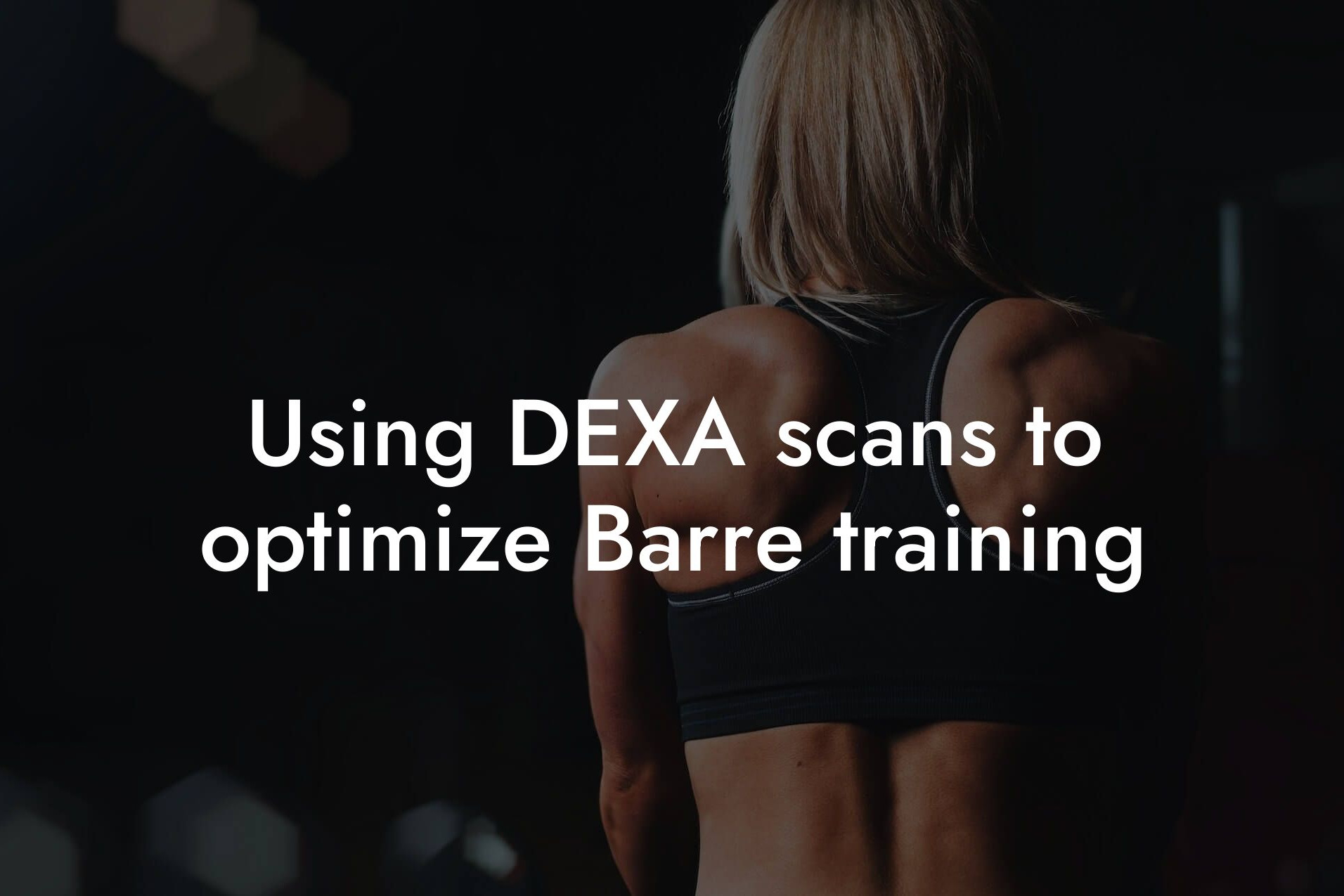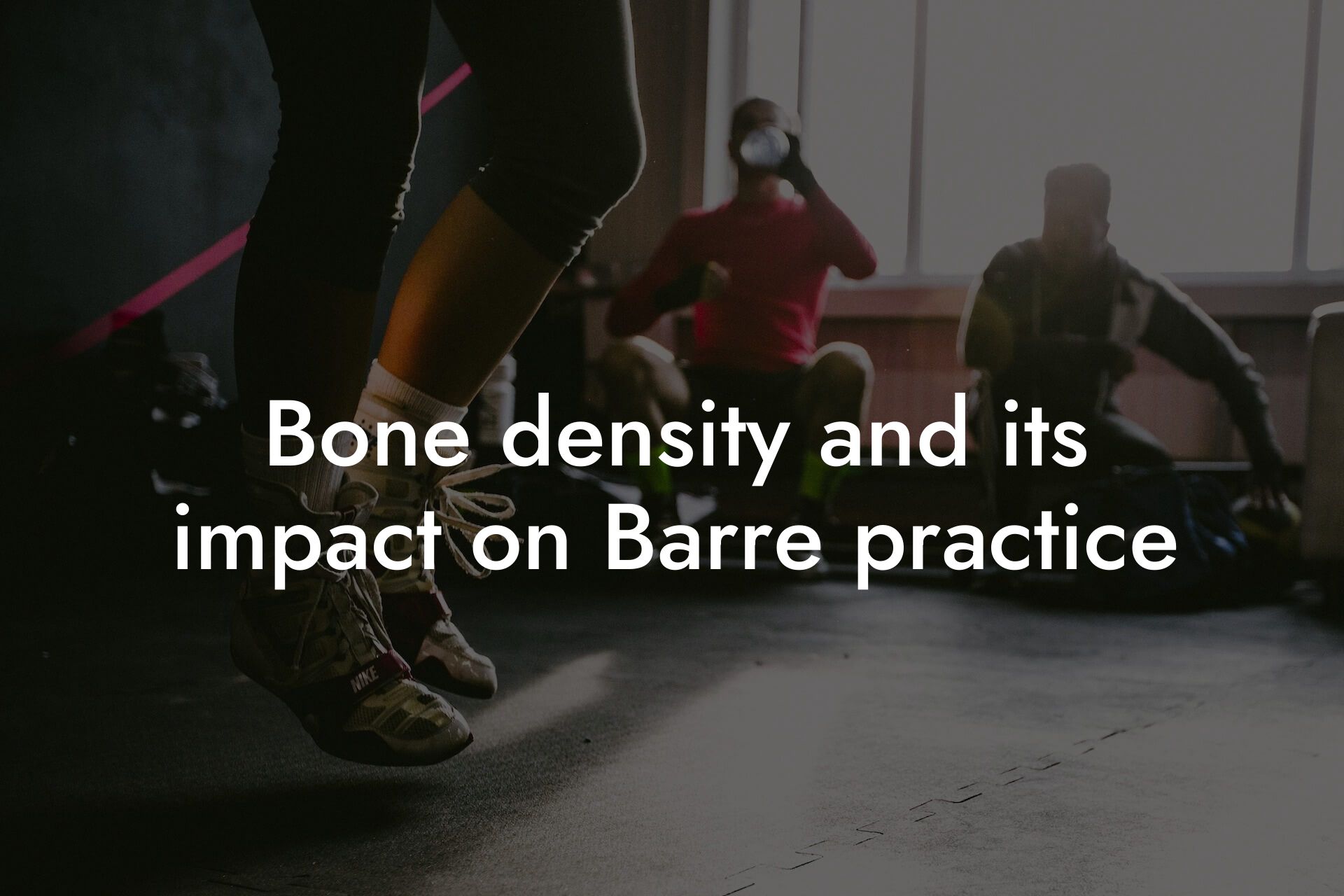As a high-earning professional, you understand the importance of maintaining a strong and healthy physique. One of the most effective ways to achieve this is through Barre fitness, a form of exercise that combines elements of ballet, Pilates, and yoga to provide a full-body workout. At the core of Barre fitness (pun intended) is, well, core strength. In this article, we'll explore the importance of core strength in Barre fitness and how it can benefit your overall health and physique.
Table of Contents
What is Core Strength?
Before we dive into the importance of core strength in Barre fitness, it's essential to understand what core strength is. Your core muscles include your abdominals, obliques, and lower back muscles. These muscles work together to provide stability, support, and movement for your entire body. Core strength refers to the ability of these muscles to generate force, stabilize, and control movement.
Why is Core Strength Important in Barre Fitness?
In Barre fitness, core strength is crucial for maintaining proper form and technique. Many Barre exercises require engagement of the core muscles to support the body and generate movement. Without strong core muscles, you may struggle to perform exercises correctly, which can lead to poor form, injury, and ineffective workouts. Strong core muscles also help improve posture, balance, and overall athletic performance.
Benefits of Core Strength in Barre Fitness
Developing strong core muscles through Barre fitness can have numerous benefits for your overall health and physique. Some of the benefits include:
- Improved posture and balance: Strong core muscles help maintain proper alignment and balance, reducing the risk of injury and improving overall athletic performance.
- Enhanced athletic performance: Core strength is essential for generating power, speed, and agility in many sports and activities.
- Better body composition: Strong core muscles can help improve body composition by increasing muscle mass and reducing body fat.
- Reduced injury risk: Weak core muscles can lead to poor form and increased risk of injury. Strong core muscles help reduce this risk by providing stability and support.
- Improved overall health: Strong core muscles can help improve digestion, reduce back pain, and enhance overall physical function.
How to Improve Core Strength in Barre Fitness
So, how can you improve your core strength in Barre fitness? Here are some tips:
- Engage your core: Make sure to engage your core muscles during Barre exercises by drawing your belly button towards your spine and maintaining a tight, stable core.
- Focus on proper form: Pay attention to your form and technique during Barre exercises. Poor form can put unnecessary strain on your core muscles and lead to injury.
- Incorporate core-specific exercises: In addition to Barre exercises, incorporate core-specific exercises like planks, crunches, and leg raises into your workout routine.
- Practice regularly: Consistency is key when it comes to improving core strength. Practice Barre exercises regularly to see improvement in your core strength.
Common Core Strength Mistakes in Barre Fitness
Even with the best intentions, it's easy to make mistakes when it comes to core strength in Barre fitness. Here are some common mistakes to avoid:
- Not engaging the core: Failing to engage the core muscles during Barre exercises can lead to poor form and ineffective workouts.
- Over-relying on momentum: Using momentum to power through Barre exercises can put unnecessary strain on the core muscles and lead to injury.
- Ignoring proper form: Ignoring proper form and technique can lead to poor engagement of the core muscles and increased risk of injury.
How to Assess Core Strength in Barre Fitness
Assessing core strength is essential to understanding your progress and identifying areas for improvement. Here are some ways to assess core strength in Barre fitness:
- Plank test: Hold a plank position for 30-60 seconds to assess your core endurance.
- Crunch test: Perform a set of crunches to assess your core strength and endurance.
- Barre exercise assessment: Assess your form and technique during Barre exercises to identify areas for improvement.
- DEXA scan: Use a DEXA scan to assess your body composition and identify areas for improvement. At Tano Performance Group, we use DEXA scans to provide our clients with a comprehensive body assessment.
In conclusion, core strength is a crucial component of Barre fitness. By understanding the importance of core strength, benefits, and how to improve it, you can take your Barre workouts to the next level. Remember to engage your core, focus on proper form, and practice regularly to see improvement in your core strength. And don't forget to assess your progress regularly to identify areas for improvement. At Tano Performance Group, we're committed to helping high-earning professionals like you achieve their fitness goals. Contact us today to learn more about our DEXA scan services and how we can help you take your physique to the next level.
Frequently Asked Questions
What is core strength and why is it important in Barre fitness?
Core strength refers to the strength and stability of the muscles in your torso, including your abs, obliques, and lower back. In Barre fitness, a strong core is essential because it provides a solid foundation for movements, helps maintain proper alignment, and enables you to generate power and control. A weak core can lead to poor posture, decreased balance, and increased risk of injury.
How does core strength impact my overall fitness?
A strong core can improve your overall fitness by enhancing your balance, coordination, and overall athletic performance. It can also help reduce your risk of injury, improve your posture, and increase your overall strength and stability.
What are the benefits of incorporating core exercises into my Barre routine?
Incorporating core exercises into your Barre routine can help improve your posture, balance, and overall stability. It can also increase your strength, flexibility, and range of motion, while reducing your risk of injury and improving your overall athletic performance.
How can I engage my core during Barre exercises?
To engage your core during Barre exercises, focus on drawing your belly button towards your spine, squeezing your pelvic floor muscles, and maintaining a long, straight line from head to heels. You can also try to imagine pulling your core muscles towards your center, as if you're trying to zip up a tight pair of jeans.
What are some common mistakes people make when it comes to engaging their core in Barre?
Common mistakes people make when engaging their core in Barre include not engaging their core muscles at all, relying too heavily on their arms and legs, and not maintaining proper alignment. Additionally, people may also hold their breath or tense up their shoulders, which can put unnecessary strain on their body.
How can I modify Barre exercises to make them more core-intensive?
To modify Barre exercises to make them more core-intensive, try adding in extra core engagements, such as holding a plank position or adding in rotational movements. You can also try using lighter weights or resistance bands to increase the challenge on your core muscles.
What are some effective core exercises I can do outside of Barre class?
Effective core exercises you can do outside of Barre class include planks, bicycle crunches, Russian twists, and leg raises. You can also try incorporating exercises that target your obliques, such as side plank variations and woodchoppers.
How often should I practice core exercises to see results?
To see results, it's recommended to practice core exercises 2-3 times per week, with at least one day of rest in between. However, this can vary depending on your individual fitness goals and needs.
Can I still do Barre if I have a weak core or core injuries?
Yes, you can still do Barre if you have a weak core or core injuries. However, it's recommended to modify exercises to accommodate your needs and abilities. You may also want to consider working with a personal trainer or fitness coach to develop a customized exercise program that addresses your specific needs and goals.
How can I prevent core injuries during Barre?
To prevent core injuries during Barre, make sure to warm up properly before class, listen to your body and take regular breaks, and focus on proper alignment and form. You should also avoid overexerting yourself and take regular breaks to stretch and recover.
What are some common core injuries that can occur during Barre?
Common core injuries that can occur during Barre include strains, pulls, and tears in the abdominal muscles, as well as hernias and other injuries to the lower back. Additionally, people may also experience injuries to their pelvic floor muscles, such as incontinence or prolapse.
How can I improve my overall core strength and stability?
To improve your overall core strength and stability, focus on incorporating a variety of exercises that target your core muscles, including planks, crunches, and leg raises. You should also incorporate exercises that target your obliques and lower back, such as side plank variations and bird dogs.
What role does core strength play in maintaining good posture?
Core strength plays a crucial role in maintaining good posture by providing a solid foundation for your spine and helping to maintain proper alignment. A strong core can help improve your posture by reducing the strain on your back and shoulders, and increasing your overall stability and balance.
How can I engage my core during everyday activities?
To engage your core during everyday activities, try to maintain good posture, engage your core muscles when lifting or bending, and focus on using your core to generate power and control. You can also try incorporating core exercises into your daily routine, such as doing a few planks or crunches during commercial breaks while watching TV.
What are some common myths about core strength and Barre?
Common myths about core strength and Barre include the idea that you need to have a six-pack to have a strong core, or that Barre is only for dancers or people with a certain body type. Additionally, people may also believe that core strength is only important for athletic performance, when in reality it's essential for everyday activities and overall health and wellness.
How can I incorporate core exercises into my daily routine?
To incorporate core exercises into your daily routine, try doing a few exercises during commercial breaks while watching TV, or incorporating them into your morning or evening routine. You can also try doing core exercises during your lunch break, or incorporating them into your daily commute.
What are some benefits of having a strong core for high-earning professionals?
Having a strong core can be especially beneficial for high-earning professionals by improving their posture, reducing their risk of injury, and increasing their overall energy and productivity. A strong core can also help improve their overall confidence and self-esteem, which can have a positive impact on their professional and personal lives.
How can I make core exercises more challenging and engaging?
To make core exercises more challenging and engaging, try adding in new and varied exercises, increasing the intensity or duration of your workouts, or incorporating props or equipment such as resistance bands or medicine balls. You can also try working out with a partner or personal trainer, or incorporating core exercises into your favorite activities or hobbies.
What are some common signs of a weak core?
Common signs of a weak core include poor posture, lower back pain, and decreased balance and stability. You may also experience fatigue, decreased energy, and decreased overall athletic performance. Additionally, people with a weak core may also experience injuries or strains more frequently.
How can I measure my progress and track my core strength?
To measure your progress and track your core strength, try taking progress photos, tracking your workouts and exercises, or using a fitness tracker or app to monitor your progress. You can also try incorporating regular assessments or evaluations into your workout routine, such as taking a plank challenge or doing a series of core exercises to test your strength and endurance.
What are some common misconceptions about core strength and Barre?
Common misconceptions about core strength and Barre include the idea that Barre is only for women, or that it's only for people who are already flexible or athletic. Additionally, people may also believe that core strength is only important for aesthetics, when in reality it's essential for overall health and wellness.
How can I make core exercises more enjoyable and fun?
To make core exercises more enjoyable and fun, try incorporating music or playlists into your workouts, working out with a friend or partner, or incorporating core exercises into your favorite activities or hobbies. You can also try trying new and varied exercises, or incorporating props or equipment such as resistance bands or medicine balls.
Here are some related articles you might love...
- Maintaining muscle tone and flexibility with Barre
- Using DEXA scans to optimize Barre training
- Bone density and its impact on Barre practice
- How to integrate Barre into a balanced fitness routine
- Nutrition tips for sustained energy in Barre classes
- Recovery strategies for Barre practitioners
- Reducing body fat for improved Barre results
- Barre for injury prevention and rehabilitation
- How body composition impacts Barre performance
Zak Faulkner
Zak Faulkner is a leading authority in the realm of physical health and body composition analysis, with over 15 years of experience helping professionals optimise their fitness and well-being. As one the experts behind Tano Performance Group, Zak has dedicated his career to providing in-depth, science-backed insights that empower clients to elevate their physical performance and overall health.
With extensive knowledge of DEXA technology, Zak specializes in delivering comprehensive body assessments that offer precise data on body fat, muscle mass, bone density, and overall physique. His expertise enables individuals to make informed decisions and achieve their fitness goals with accuracy and confidence. Zak’s approach is rooted in a deep understanding of human physiology, combined with a passion for helping clients unlock their full potential through personalised strategies.
Over the years, Zak has earned a reputation for his commitment to excellence, precision, and client-focused service. His guidance is trusted by top professionals who demand the best when it comes to their health. Whether advising on fitness programs, nutritional strategies, or long-term wellness plans, Zak Faulkner’s insights are a valuable resource for anyone serious about taking their health and fitness to the next level.
At Tano Performance Group, Zak continues to lead our Content Team revolutionising how professionals approach their physical health, offering unparalleled expertise that drives real results.




